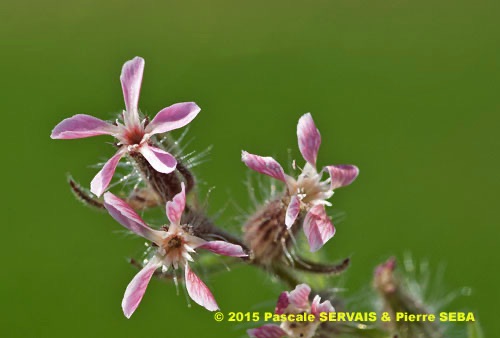
Silene gallica L.
Fam. : Caryophyllaceae
© Pascale SERVAIS & Pierre SEBA, 2019. Tilo Botanica: Flore de Tilos et du Dodécanèse / Flora of Tilos and of the Dodecanese
English translation by Brenda Bradbury, Howard Bradbury and Stéphane Léonard
Plante herbacée, hermaphrodite, à poils collants, à tiges dressées et ramifiées.
Feuilles opposées, simples, lancéolées à linéaires, les inférieures pétiolées, velues.
Fleurs à symétrie radiaire, blanches ou roses, souvent à taches rouges à la base des pétales (forme jadis considérée comme une sous-espèce), de 6 à 10 mm de diamètre, dressées, réunies en grappes unilatérales. Fleurs ordinairement toutes tournées du même côté. Corolle à 5 pétales libres, échancrés ou non. Calice à 5 sépales bulbeux, de 7 à 10 mm de long, resserrés au sommet, à nervures saillantes et masquant la base des pétales. 10 étamines dont 5 un peu plus courtes. 3 styles. Ovaire supère.
Fruits, capsules à graines brun sombre, couvertes de nombreux petits tubercules.
___________________________
Plant herbaceous, hermaphrodite, with sticky hairs. Stems erect and branched.
Leaves opposite, simple, lanceolate to linear, the lower ones petiolate, very hairy.
Flowers radially symmetrical, white or pink, often with red marks at the base of the petals (form formerly regarded as a subspecies), from 6 to 10 mm in diameter, erect, joined together in unilateral racemes. Flowers usually all turned on the same side. Corolla with 5 free petals, indented or not. Calyx with 5 bulbous sepals, from 7 to 10 mm long, tightened at the top, with a protruding vein masking the base of the petals. 10 stamens including 5 a little shorter. 3 styles. Ovary superior.
Fruits, capsules with dark brown seeds, covered in numerous small tubers.
Descripteurs / Identifying features
1
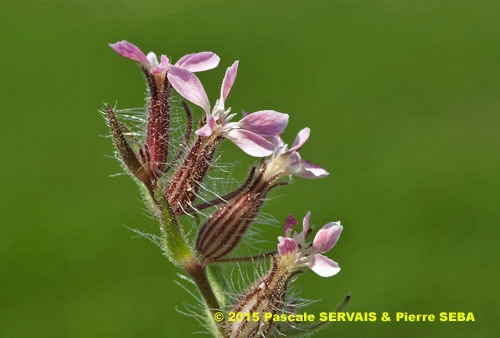
2
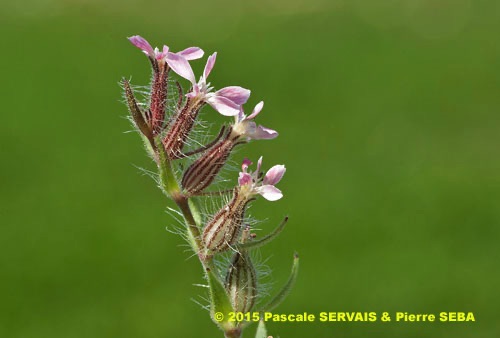
3
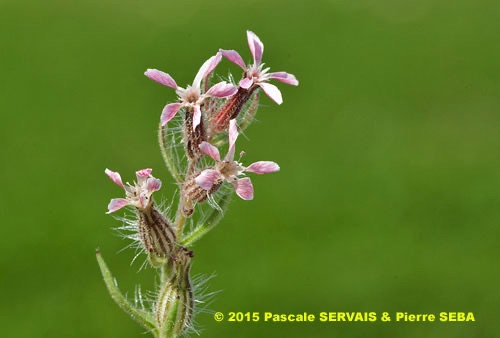
4
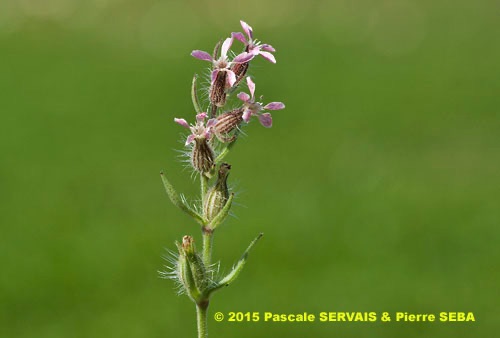
5
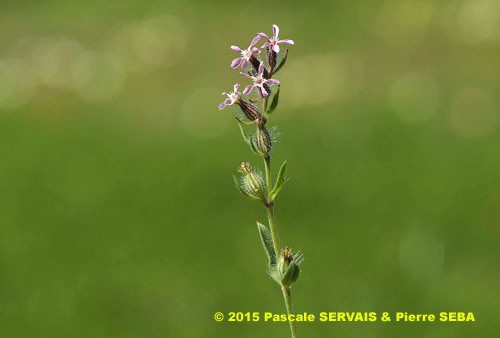
6
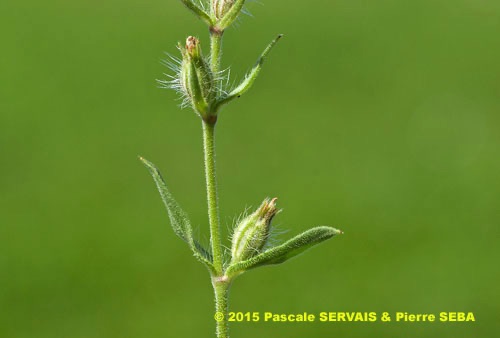
7
Étymologie / Etymology :
Silene : emprunt du grec ancien Σιληνός, -ου (nom propre)
= Silène, le compagnon du dieu du vin Dionysos, en référence à la
ressemblance du calice gonflé de ces plantes avec Silène, le
compagnon ventripotent de Dionysos.
Gallica : emprunt du latin gallicus, -a, -um (adj.) [ < Gallia, -ae
(nom propre) = la Gaule ] = de France, qui vient de France.
Silene : borrowed from Classical Greek Σιληνός, -ου (proper noun)
= Silenus, the companion of the wine-god Dionysus, referring to the
resemblance of the inflated calyx of these plants with Silenus, the
pot-bellied companion of Dionysus.
Gallica : borrowed from Latin gallicus, -a, -um (adj) [ < Gallia, -ae
(proper noun) = Gaul ] = of or from France.
Synonymes / Synonyms :
Silene gallica var. quinquevulnera (L.) Mert. & W.D.J.Koch
Corone gallica (L.) Fourr.
Cucubalus sylvestris Lam.
Cucubalus variegatus Lam.
Lychnis vulnerata Scop.
Oncerum gallicum (L.) Dulac
Silene agrestina Jord. & Fourr.
Silene agricola E.H.L.Krause
Silene anglica L.
Silene arvensis Salisb.
Silene bohemica Jord. & Fourr.
Silene candollei Guss.
Silene cantabrica Jord. & Fourr.
Silene cerastoides L.
Silene cerastoides Noulet
Silene cruentata Jord. & Fourr.
Silene distycha Webb
Silene gallica subsp. anglica Á.Löve & D.Löve
Silene gallica var. gallica
Silene glomerata Gay
Silene jucunda Jord. & Fourr.
Silene littoralis Jord.
Silene lusitanica L.
Silene marginata Schott
Silene quinquevulnera L.
Silene reflexa Moench
Silene rigidula L.
Silene sciotica Otth
Silene suboccultata Jord. & Fourr.
Silene sylvestris Gaterau
Noms vernaculaires / Common names :
Noms français / French names :
Cornillet à cinq gouttes de sang — Lychnis vulgaire —
Silène à cinq blessures — Silène à cinq plaies —
Silène d’Angleterre — Silène de France.
Noms grecs / Greek names :
Σιληνή γαλλική — Σιληνή η γαλλική.
Noms anglais / English names :
Common catchfly — French catchfly — Small-flowered catchfly —
Windmill pink.
Noms allemands / German names :
Französisches Leimkraut — Rauhe Nelke.
Nom espagnol / Spanish name :
Carmentilla.
Nom italien / Italian name :
Silene gallica.
Habitat :
Cultures - Lieux incultes - Chemins.
Cultivated places - Waste ground - Waysides.
Îles / Islands :
Patmos - Tilos.
Hauteur / Height range :
De 10 cm à 50 cm.
From 10 cm to 50 cm.
Floraison / Flowering time :
De mars à juin.
From March to June.
Groupe / Classification :
Dicotylédones.
Dicotyledons.
Pérennité / Lifespan :
Annuelle.
Annual.
Description :
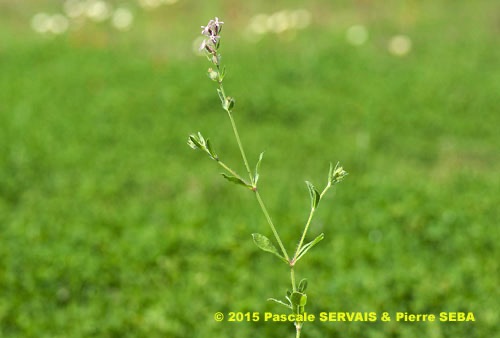
8
Clés dichotomiques et descripteurs distinctifs des 6 espèces / Dichotomous keys and distinctive identifying features of the 6 species
Photo 1 :
Localisation / Location : Tilos, Megalochorio, Erystos
Date : 16/03/2015
GPS : Lat. 36,43421° N / Long. 27,34915° E / Alt. 8 m
Type : Photographie numérique / Digital Photograph (10 mégapixels)
Photo 2 :
Localisation / Location : Tilos, Megalochorio, Erystos
Date : 16/03/2015
GPS : Lat. 36,43421° N / Long. 27,34915° E / Alt. 8 m
Type : Photographie numérique / Digital Photograph (10 mégapixels)
Photo 3 :
Localisation / Location : Tilos, Megalochorio, Erystos
Date : 16/03/2015
GPS : Lat. 36,43421° N / Long. 27,34915° E / Alt. 8 m
Type : Photographie numérique / Digital Photograph (10 mégapixels)
Photo 4 :
Localisation / Location : Tilos, Megalochorio, Erystos
Date : 16/03/2015
GPS : Lat. 36,43421° N / Long. 27,34915° E / Alt. 8 m
Type : Photographie numérique / Digital Photograph (10 mégapixels)
Photo 5 :
Localisation / Location : Tilos, Megalochorio, Erystos
Date : 16/03/2015
GPS : Lat. 36,43421° N / Long. 27,34915° E / Alt. 8 m
Type : Photographie numérique / Digital Photograph (10 mégapixels)
Photo 6 :
Localisation / Location : Tilos, Megalochorio, Erystos
Date : 16/03/2015
GPS : Lat. 36,43421° N / Long. 27,34915° E / Alt. 8 m
Type : Photographie numérique / Digital Photograph (10 mégapixels)
Photo 7 :
Localisation / Location : Tilos, Megalochorio, Erystos
Date : 16/03/2015
GPS : Lat. 36,43421° N / Long. 27,34915° E / Alt. 8 m
Type : Photographie numérique / Digital Photograph (10 mégapixels)
Photo 8 :
Localisation / Location : Tilos, Megalochorio, Erystos
Date : 16/03/2015
GPS : Lat. 36,43421° N / Long. 27,34915° E / Alt. 8 m
Type : Photographie numérique / Digital Photograph (10 mégapixels)

Google Maps
Google Maps
Google Maps
Google Maps
Google Maps
Google Maps
Google Maps
Google Maps